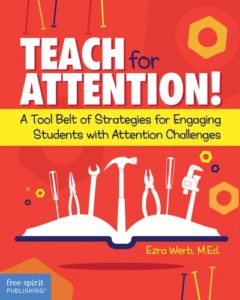Engaging Students with Attention Challenges
Teach for Attention! A Tool Belt of Strategies for Engaging Students with Attention Challenges
By Ezra Werb, M.Ed.
(Free Spirit Publishing, 2019 – Learn more)

Let’s start with two statistics shared in the book.
1. About 8.4% of kids in the United States have an ADHD diagnosis.
2. About 30% of students with ADHD are failing classes and/or repeating grades.
Undoubtedly some who read those statistics are reacting by decrying the over-diagnosis of ADHD, and there is likely some truth to that. However, it is not a stretch for most working teachers to concede that there are large numbers of students who seem to struggle with attention.

Introduction
In addition to offering the statistics concerning ADHD, this brief section sets the tone for the book by sharing the basic philosophies and underpinnings about how to help students maintain focused attention, including the following:
1. The best strategies help build confidence, lower anxiety, capitalize on interests, meet sensory needs, and build self-awareness to sustain mental energy.
2. Success breeds success, thus helping students be successful and notice their successes is key.
3. Teachers need to learn to “play offense, not defense” (p 13.), always planning ahead to help students stay focused.
The author (a former resource teacher and now an educational therapist) has a kind and friendly tone that comes across as if he were a trusted and non-judgmental colleague sharing some good ideas he’s learned with the reader.
That stance is driven home with his note that the book can be read from cover to cover, or in bits and pieces as the reader needs them. To make that easier, Werb drops in a few summarizing paragraphs labeled, “The Big Takeaway” at the end of each chapter.
Chapter 1: Get Interest Rates Up
This chapter offers tips on incorporating students’ interests into daily teaching and learning to help them focus on the lessons. Truly, while there is nothing groundbreaking here, it is information that bears repeating over and over again for as long as any of us teach.
The bottom line is that we teach kids, not curriculum, and when we know our kids, we can more easily reach them. The author writes that when we name-drop things kids like (think Minecraft, student names, Fortnight, a band or singer, a character from TV or a movie, etc.) it can seem to “jump-start” a student’s, or group of students’ thinking (p. 24.)
Chapter 2: Play the Confidence Game
Building on the concept that success breeds success, Werb shares ways to “raise self-esteem and reduce stress” (p, 36) in chapter two. From offering praise, lowering work load or intensity (and then gradually increasing it again), to modeling that making mistakes is a normal part of learning, this chapter is filled with good advice for working educators.
My favorite nugget is the reminder that “confidence and success have a reciprocal relationship. If you have one, the other tends to follow” (p. 58). Who doesn’t know that to be true in their own life? The key is to harness that truth to help students be more successful too.
Chapter 3: Let Out the Fizz
Fidget! Wiggle! Move! Many who have attention difficulties know that that keeping the body busy can help focus the mind. For full disclosure, I have ADHD and am medicated for it, but still struggle a bit with a need for sensory input.
Werb shares many good tips for increasing movement in chapter four. He discusses both sating sensory needs (like mine) and integrating movement into our lesson plans (for more on that, read my post here.) I really appreciated his practical reminder that fidgets become a problem “when the fidget is so cool looking that a student can’t help but focus on it and play with it. [When] “it’s no longer a fidget–it’s a toy” (p. 63).
Chapter 4: Send Them in the Write Direction
We have a saying at my school, “Writing is Rigor.” Students who struggle with attention often also struggle with writing. This chapter has the goal of offering teachers tools to make writing easier for students.
Technology enhancements (slide presentation software, word processing, and speech to text tools) are explored, and so are other ideas such as graphic organizers and chunking writing tasks into manageable sub-assignments.
Chapter 5: Make a Long Story Feel Short
Reading, like writing, can be a challenge for children (and adults) who have trouble with focus. As an educator who has emphasized helping students learn to and love to read for 25 years, I can say that this chapter offers spot-on expert advice. Ebooks, graphic novels, short reads, and audio texts are all suggested. Werb also shares information about helping students make connections to the texts they read.
By far the most interesting tip is focused on frontloading books for readers. Werb explains that sometimes offering an outline of a story or even a “spoiler” or two can help students stay focused on the text as they anticipate what’s coming next.
Chapter 6: Teach in High Definition
Clutter is hard for the ADHD brain. In chapter six, we learn about how to reduce or manage visual clutter to help students focus. Thinking of less as more in terms of both classroom decoration and worksheet construction can be helpful. So, says the author, can be color coding, offering visual images and icons, and emphasizing key words.
Also discussed is the importance of providing students with ample models and/or rubrics that help them see what quality work looks like before, during, and after students are expected to complete a given task.
Chapter 7: Adjust Their Mirror
The final chapter is a short one that provides strategies for helping students learn to self-monitor their own ability to stay focused. The author reminds us that scolding and constant reminding do not work well. Instead, he writes, we should work on “Helping students develop self-awareness that enables them to employ a quality check over their behaviors” (p. 164) which in turn helps students stay focused and engaged.
Tools shared include cue-cards, emotional state check-ins, checklists, and timers. All are tried and true, and none will be surprising to most veteran teachers, but the reminder is great and they’re great to share with newbies, too.
A Great Tool Belt!
I really liked Teach for Attention! A Tool Belt of Strategies for Engaging Students with Attention Challenges. It is a good read for any active educator or parent. The author has an easy-to-read, inviting style and the tips offered are practical and ready to use tomorrow.
Rita Platt (@ritaplatt) is a National Board Certified Teacher with master’s degrees in reading, library, and leadership. Her experience includes teaching learners in remote Alaskan villages, inner cities, and rural communities. She currently is a school principal, teaches graduate courses for the Professional Development Institute and blogs at Heart of the School for MiddleWeb. She is the author of Working Hard, Working Happy.






























